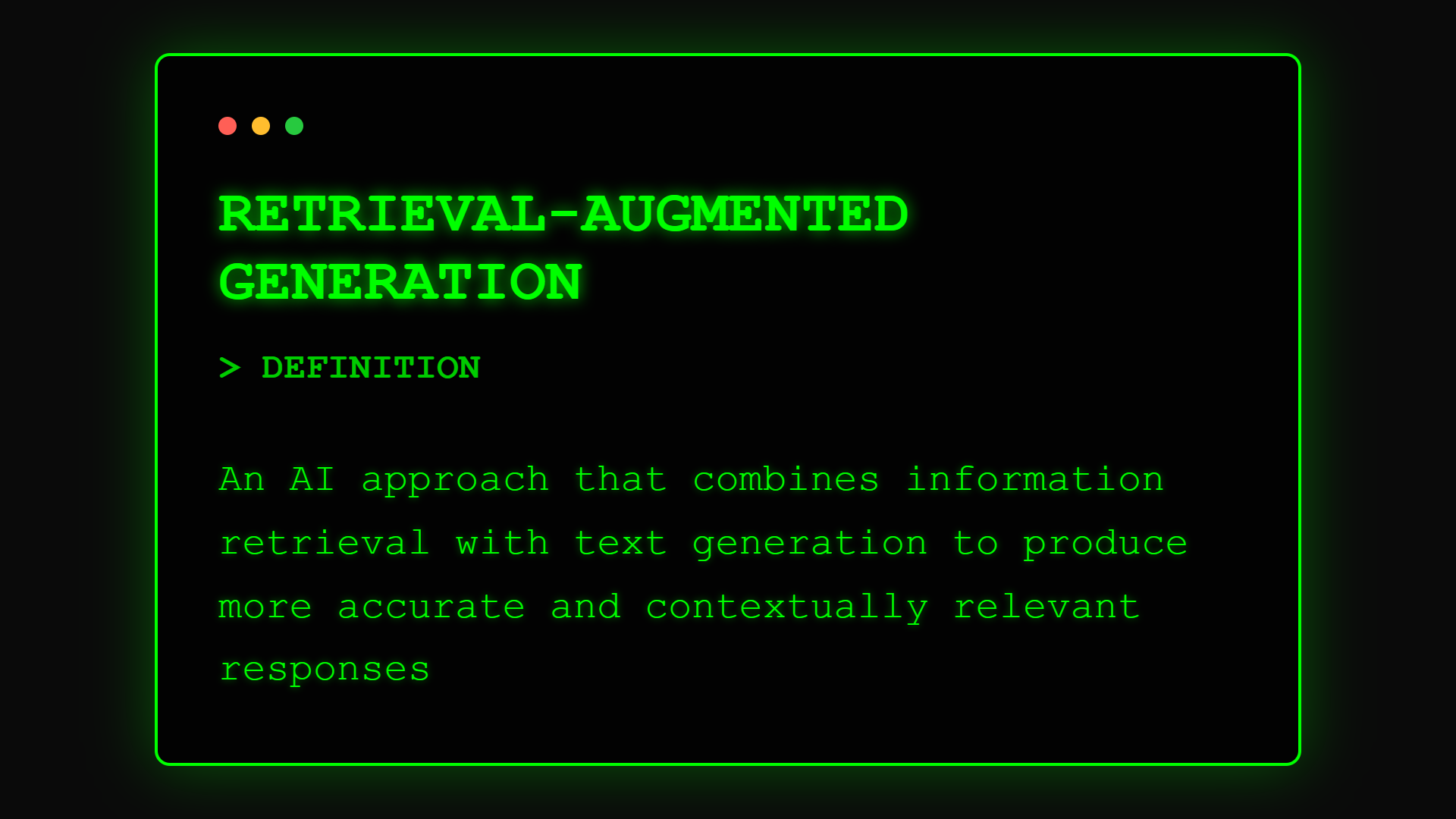AI Terms
What is Retrieval-Augmented Generation? Making AI Smarter with Your Data

ChatGPT doesn't know your company's latest sales figures. Claude can't access your product documentation. But what if AI could tap into your real-time data while maintaining its language superpowers? That's RAG—the technology making AI actually useful for business.
The Innovation That Changed Everything
Retrieval-Augmented Generation was introduced by Facebook AI Research in 2020 as a solution to the knowledge limitations of language models. The breakthrough combined the fluency of AI with the accuracy of information retrieval.
Meta AI defines RAG as "a framework that enhances language model outputs by retrieving relevant information from external knowledge sources and incorporating it into the generation process, grounding responses in factual data."
RAG gained massive adoption in 2023 as businesses realized it could solve AI's biggest problems: hallucinations, outdated information, and lack of company-specific knowledge.
RAG in Business Terms
For business leaders, RAG means giving AI access to your real-time data, documents, and knowledge bases, so it can provide accurate, current, and company-specific answers instead of generic responses.
Think of RAG as connecting AI's brain to your company's filing cabinet. Instead of relying solely on what it learned during training, AI can now look up current information, check facts, and reference your specific documents before responding.
In practical terms, this transforms AI from a general assistant into an expert on your business who can answer questions about your products, policies, and data with perfect accuracy.
The RAG Architecture
RAG consists of these essential components:
• Vector Database: Your knowledge stored as mathematical representations, enabling lightning-fast searching through millions of documents to find relevant information
• Retrieval System: The search mechanism that finds the most relevant chunks of information based on the user's query, like a super-intelligent librarian
• Language Model: The AI that takes retrieved information and generates natural, coherent responses, combining facts with conversational ability
• Embedding Model: Converts text into numerical vectors that capture meaning, allowing semantic search beyond simple keyword matching
• Orchestration Layer: Coordinates the retrieval and generation process, deciding what to search for and how to combine information
How RAG Works
The RAG process follows these steps:
Query Understanding: When you ask a question, the system first converts it into a vector representation that captures its meaning and intent
Information Retrieval: The system searches your knowledge base for the most relevant documents, passages, or data points related to your query
Augmented Generation: The language model receives both your original question and the retrieved information, then generates a response grounded in actual data
This process happens in seconds, combining the best of search technology with AI's ability to synthesize and communicate naturally.
RAG Implementation Patterns
RAG systems come in several varieties:
Type 1: Simple RAG Best for: Basic Q&A over documents Key feature: Straightforward retrieval and generation Example: Customer support over product manuals
Type 2: Advanced RAG Best for: Complex queries requiring reasoning Key feature: Multi-step retrieval and verification Example: Financial analysis combining multiple data sources
Type 3: Conversational RAG Best for: Interactive dialogues with context Key feature: Maintains conversation history Example: AI assistants for employee queries
Type 4: Agentic RAG Best for: Autonomous task completion Key feature: Can take actions based on retrieved info Example: Automated report generation
RAG Success Stories
Here's how businesses leverage RAG:
Financial Services Example: Morgan Stanley equipped 16,000 advisors with RAG-powered assistants accessing internal research, reducing information retrieval time by 70% while ensuring compliance accuracy.
Healthcare Example: Cleveland Clinic's RAG system helps doctors access the latest treatment protocols from thousands of medical documents, improving decision speed by 50% with zero outdated information.
Retail Example: Home Depot's customer service uses RAG to access product specs, installation guides, and inventory data, resolving queries 40% faster with 90% first-contact resolution.
Building Your RAG System
Ready to ground your AI in reality?
- Start with understanding Large Language Models
- Learn about Vector Databases for storage
- Explore Embeddings for semantic search
- Implement with our RAG Deployment Guide
FAQ Section
Frequently Asked Questions about RAG
Part of the [AI Terms Collection]. Last updated: 2025-01-10